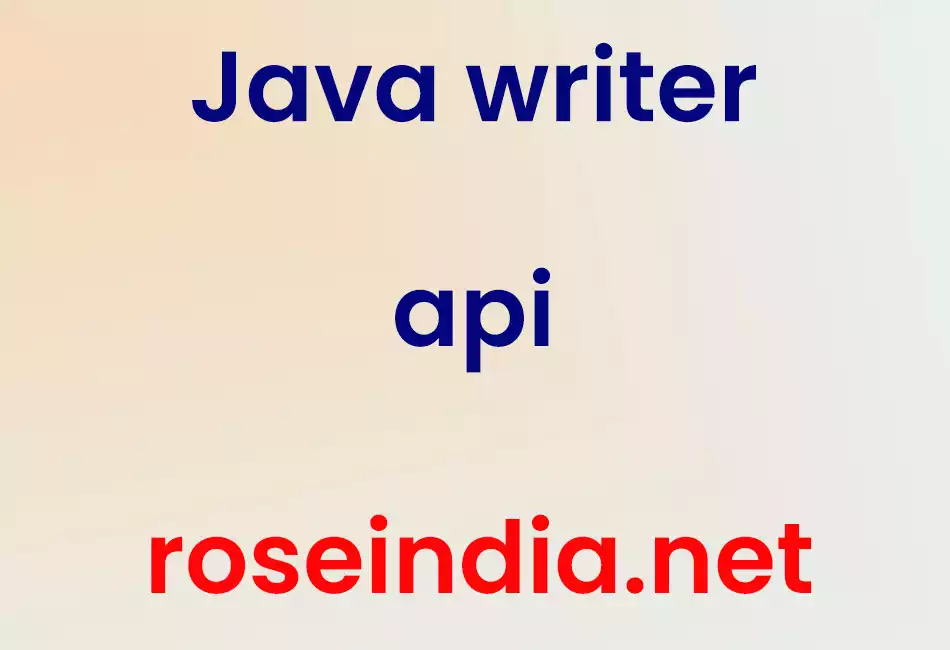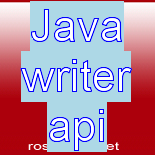Following web page demonstrates the Java writer api. Brief but to the point description is given below regarding java abstract writer subclasses, field summary, constructor summary and method summary.

Java writer api
Following web page demonstrates the Java writer api. Brief but to the point description is given below regarding java abstract writer subclasses, field summary, constructor summary and method summary.
Abstract Writer subclasses
BufferedWriter:- A subclass inside abstract writer class that creates a
buffer for the character output stream for its better processing. The buffer
created by the class is a temporary memory where the characters written
into character output stream is buffered. The buffer created has its default
size which is large enough for most purposes but this size can be specified.
In order to provide the buffering functionality in the filtered stream. This class is layered with other writer subclasses to make filtered stream required.
Syntax for creating class object :- BufferedWriter
br = new BufferedWriter();
Syntax for creating a filtered stream:- PrintWriter out = new PrintWriter
(new BufferedWriter (new FileWriter ( "rose.txt" ))) ;
If no buffer is set for the character out stream, then
when ever the print() method is invoked, the characters will directly convert in
to bytes and will we instantly written to the file, and that would be very
disorganized.
CharArrayWriter :- Class CharArrayWriter extends
abstract class writer. Class creates a buffer that can be used as a
writer. The buffer created increases its size when any data is written into the
character output stream. Class also provides some methods like toCharArray()
and toString() methods for retrieving the
data.
Syntax for creating class object :- CharArrayWriter
rose = new CharArrayWriter(0);
There is no need to layer BufferedWriter class object for buffering because
class ClassArrayWriter creates a self growing buffer by itself for the efficient
processing of underlying output stream.
FilterWriter :- Class FilterWriter
extends abstract writer class. Class generates filtered character streams by
filtering the writer passed inside the constructor of the class object.
There are some methods that the class contains for passing all the requests to
the underlying output stream.
Class inherits write method from java.io.writer abstract class.
Class also inherits methods from java.lang.Object class and they are as
follows: clone, equals, finalize, getClass, hashCode, notify, notifyAll, toString, wait, wait, wait
.
Syntax used for filtering :- FileWriter filter = new
FilterWriter (writer_object_name);
Note : - Subclasses of filter writer class should override
the class methods.
OutputStreamWriter :- Class OutputStreamWriter
extends the abstract class writer. This class creates a connecting
channel from a character output stream to a binary stream. The class simply
turns a character output stream into a byte output stream.
OutputStreamWriter
has a specified charset with which it encodes the data written to
it, in to bytes.
It has to be noted that the data as characters passed to write method are
first get encoded in to bytes by the encoding converter defined in the
OutputStreamWriter class and then are get buffered and after that, the buffered
value is written in to the underlying output stream.
The buffer can be set to a definite size with which the data will be
buffered. Also one can use the default size of the buffer, which is quite large
and fit in most cases.
Syntax for creating the class object :- OutputStreamWriter rachel = new
OutputStreamWriter();
Inside the parentheses you can pass the object of ByteArrayOutputStream
class object.
Syntax with examples for using the class:-
ByteArrayOutputStream out = new ByteArrayOutputStream();
OutputStreamWriter rachel = new OutputStreamWriter(out);
rachel.write("roseindia.net");
Writer rose = new BufferedWriter (new OutputStreamWriter (OutputStream arg,
String arg));
Here for OutputStream argument you can be System.out
& for String arguments following codes in double quotes can be passed
:
Codes = CP437, cp850, CP858, Cp1252 .
PipedWriter :- This class extends
abstract class Writer. Character output streams written by the
class are called communications pipes. Data written to piped stream can only
be read or viewed through PipedReader class methods. For reading
the data , both the class objects need to be connected first.
Connection can be done in two ways, as demonstrated below.
Syntax for creating class Objects :- PipedWriter writer = new PipedWriter();
PipedReader reader = new PipedReader();
Syntax for connecting the classes :- PipedWriter writer = new
PipedWriter(reader);
or
writer.connect (reader);
Syntax for reading the data :- reader.read();
Method throws IOException if circular buffer is empty. This means no
data is written on the stream.
PrintWriter :- Class PrintWriter extends Writer class. Class
inherits all the methods of PrintStream and is used to write text output
streams. The texts written by class are the formatted representations of other Writer
class objects. 'formatted representations' means the data is already
taken and buffered. Class takes the Writer objects as argument. Class does not
show any IOException, but its constructors can generate this exception. In the
class with checkError(), programmer can check for any generated errors.
Syntax for creating class object :- PrintWriter pwd = new PrintWriter();
Syntax for applying :- ByteArrayOutputStream out = new
ByteArrayOutputStream(0);
OutputStreamWriter writer = new OutputStreamWriter(out);
PrintWriter print = new PrintWriter(writer);
pwd.write();
pwd.append();
pwd.print();
StringWriter :- StringWriter is
a public class that extends abstract class Writer. Data
passed to the object of class through the class methods are stored in a string
buffer class object. Values inside the string buffer can be generated on the
console as string. In StringWriter class flushing is automatic done when the
standard output methods print & println are invoked to print
the values hold by the string buffer object.
Methods of the class can still be invoked, even after the underlying stream
is closed.
Syntax for creating class object :- StringWriter str
= new StringWriter();
Syntax for using class object:- StringWriter rose = new
StringWriter();
rose.append('r');
rose.write("ose");
rose.write("india");
either
String news = rose.toString();
StringBuffer = new StringBuffer(news);
or
StringBuffer = new StringBuffer(rose.toString());
FileWriter :- Class FileWriter has
public access and inherits OutputStreamWriter class. Class usually used
for connecting a character output stream to file. Class with its inherited
methods can also write character files. Class can only write streams of
characters and not the raw bytes. For writing raw bytes FileOutputStream
class is used.
Syntax for creating class object:- FileWriter rd = new
FileWriter("rose.txt");
Syntax for using the objec in writing filest:- FileWriter eve =
new FileWriter("rose.txt");
eve.write("roseindis.net");
eve.flush();
Note:- Above demonstrated usage of the class object, will work only
if a file with name "rose.txt" exist.
Syntax for using the class in connecting character output stream to a file :-
File fd = new File("rose.txt");
PrintWriter out = new PrintWriter(new FileWriter(fd));
out.write("newstrack india");
out.flush();
Here class FileWriter is connecting the underlying character output
stream of PrintWriter to text file "rose.txt";
Writer Field Summary
lock :-
Object lock is used to synchronize the operations taking
place inside the underlying character stream. Here by synchronize, it means
applying lock feature on methods and other operations taking place inside the
stream. In Locking, java synchronize keyword is used.
This field object is protected that means it will be available to subclasses and
classes in the same package.
By synchronizing the methods few errors that are stopped before generation
are as follows:
Thread Interference :- Generates when more than one thread attempts to
access same shared data.
Memory Consistency Errors:- Generates when the views of more than one
thread mismatch regarding certain shared memory.
Example:- For a int variable 'c' one thread A generates value 4 and other
thread generates value 5.
Note :- There are still several other errors that are avoided but
demonstrated here.
Writer constructor summary
Class has only two constructor forms.
protected Writer() :- Constructor is used to create a new character
stream. And will be available to subclasses and classes in the same
package.
protected Writer(Object lock) :- With this constructor form a new
character stream is created and also synchronization of the operations in stream
is done with lock object. Use of stream
created by this constructor form will be available to subclasses and classes in
the same package.
Writer method summary
Abstract class Writer possess several abstract methods
that are not implemented in the abstract class, but in subclasses. All the
methods that the class contains are described below.
append() : - This method is used append or add character data to the
underlying character stream. Method possess several constructor forms as
mentioned below:
append(CharSequence csq) , append(CharSequence csq, int start, int end)
With these constructor forms method can append a portion or complete CharSequence
interface value in to the stream.
close()
This method is used to close the underlying stream. Method first
flushes the stream and then close it. Method is abstract and void type. Method throws IOException. This exception comes when an input/output
operation is takes place.
Syntax for using the method:- PrintWriter out = new
PrintWriter(new FileWriter("rose.txt"));
out.println("roseindia.net");
out.close();
flush()
Method flushes the stream. Flushing means flowing the data from the stream without closing it. Method is abstract and void type. Method throws IOException. This exception comes when an input/output operation is takes place.
Syntax for using the method:- PrintWriter out = new
PrintWriter(new FileWriter("rose.txt"));
out.println("roseindia.net");
out.flush();
write()
Method
writes characters in to the stream. This method has several constructor forms as
mentioned below.
write(char[] cbuf) :- With this constructor form method writes an array
of characters.
write(char[] cbuf, int off, int len) :- With this constructor form method
writes a portion or part of an array of characters.
write(int c) :- With this only a single character can written.
write(String str) :- With this a string value can be written in to the
stream.
write(String str, int off, int len):- With this a subsequence or portion
of string value is written to the stream.
Method's this constructor form write(char[] cbuf, int off, int len)
is abstract and void type and rest all are just void type.



